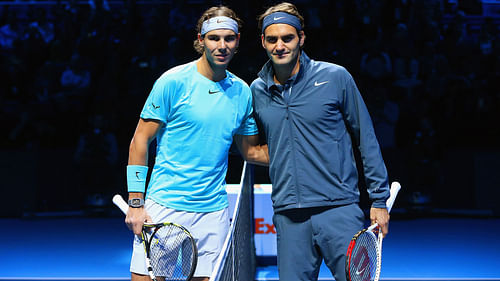
Analyzing Rafa Nadal’s domination of Roger Federer on outdoor hardcourts

A decade of domination
The rivalry between Nadal and Federer is one of the biggest ones in the entire history of the sport. Both of them have competed for the biggest prizes in the sport in the last decade, with Nadal coming out on top in most of their matches against each other. Rafa has been almost unbeatable on clay for the last 10 years, so his domination over Federer can be explained partly by that (Nadal leads Federer 13-2 on clay).
What may come as a surprise to most tennis fans, however, is the magnitude of domination Nadal has had over Federer on outdoor hardcourts. Nadal leads Federer 8-2 on outdoor hardcourts. Yes, we are not talking clay, but hardcourts!
Outdoor hardcourts are the major playing surface in modern day tennis. More than 70% of the tennis calendar is played out there. Two of the four Grand Slams are played on outdoor hardcourts. These courts demand the best out of players from the perspective of fitness, agility, speed and endurance. They are a great leveler for all players.
If we look historically, Federer has been the most successful outdoor hardcourt player ever with 9 Grand Slam titles (5 US Opens, 4 Australian Opens).
Nadal’s incredible record against Federer
Nadal himself has been an all-time great on hardcourts, with three Grand Slam titles so far on the surface and six Slam finals, but Federer would naturally be expected to be the better player on this surface. However, against Nadal he has struggled throughout his career on this surface too.
Their first ever meeting was on the hardcourts of Miami in 2004, and a teenage Nadal aged only 17 beat the then Australian Open and Wimbledon champion in straight sets.
This trend continued in the future too, and Nadal continued to dominate him on outdoor hardcourts. In their 10 matches on outdoor hardcourts, Federer has managed to win only two, with none of those coming in their three Grand Slam encounters on the surface.
Their first ever Grand Slam encounter on hard courts happened in the finals of Australian Open 2009. Nadal had played a 5-hour semifinal against Fernando Verdasco and was considered an underdog coming into the final against Federer. However he emerged victorious in a five-set match which left Federer completely broken and devastated. Images of Federer cring in the post match presentation are part of tennis folklore now.
Even on the fastest of outdoor hardcourts, at Cincinati Masters, Nadal won against Federer in their only encounter on that surface, beating Federer there in 3 tight sets in the 2013 edition of the tournament. Nadal went on to win that tournament.
One of the factors behind this domination by Nadal has been attributed to the bad match up issue. Nadal’s extreme topspin served into Federer’s one-handed backhand has given many nightmares to the great man. The ball bounces very high and out of Federer’s comfort zone, making it difficult for him to hit a strong ball into play.That said, a player as gifted as Federer, often touted by some as the greatest player of all time, should have found a way to overturn this problem. However, he has failed to do so.
It’s not just about Rafa’s topspin against Federer’s backhand
What may have hurt Federer in those matches, more than pure skill on hardcourts, is mental toughness. Out of their first three matches on outdoor hardcourts, Nadal won two, even though he was a teenager at that time.
Nadal seemed to have gotten into Federer’s head since the very beginning, and losing the 2008 Wimbledon and 2009 Australian Open finals against the great Spaniard may have been the breaking point for Federer. Ever sincethen, he has seemed mentally very vulnerable against Nadal, and often the patterns of play Nadal employs break his morale and confidence.
Federer’s serve loses its usual venom against Nadal, and he seems a shadow of his confident self when facing his biggest foe. Federer often seems dazed, as if lost in a mirage while facing Nadal.This mental block can be the biggest reason behind his surprisingly poor record against Nadal on outdoor hardcourts, a surface on which he is the most successful tennis player in history.
Looking ahead, it would be safe to say that the lopsided head-to-head of 2-8 versus Nadal on outdoor hardcourts can only get worse now, as Federer is 33 and past his prime, while Nadal at 28 still has a few good years of tennis left in him.
Whenever in the future, the Federer-Nadal rivalry is discussed, this lopsided head-to-head on outdoor hardcourts will be one of the biggest arguments of Nadal fans about his superiority over the mighty Federer.